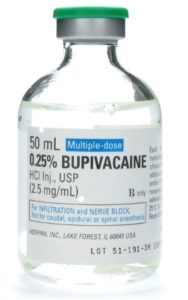Podcast: Play in new window | Download (Duration: 32:59 — 30.2MB)
Subscribe: Apple Podcasts | RSS | More
(*Hypothetical case)
You are the anaesthetist on for obstetrics and a young woman is rushed from labour ward into your theatre for an emergency caesarean for fetal distress. Your registrar is talking with the patient and so you help with the team time out discussion. The obstetrician leading this asks “can you please give 2g of Cefazolin?”. No worries – you grab the 20ml syringe and give the antibiotics over the next 30seconds whilst you help slide the patient onto the table and you instruct your registrar to start topping up her epidural. Your registrar says “no worries” but then looks confused and turns to ask you “where is my syringe?” With a sudden sickening feeling building in your stomach you look down at the now empty 20ml syringe in your hand. You slowly roll it over to reveal a previously hidden sticker………………….. “bupivacaine 0.5%”
Do you ever use local anaesthetics?
This sort of local anaesthetic misadventure is one of those life threatening scenarios which make most anaesthetists break out in a cold sweat but the truth is this is a topic that everyone who uses local anaesthetics needs to be aware of. Indeed many of the reported cases of this life threatening complication have been local anaesthetics used by surgeons, dentists, and other health care practitioners.

What is LAST? Local Anaesthetic Systemic Toxicity
Local anaesthetics are amazing analgesic medications which have many advantages over analgesics like opioids (we here at obsgynaecritcare are big fans of regional analgesia techniques). However in the wrong dose or route these medications block sodium channels in the heart and brain & can cause lethal CNS and cardiac toxicity.
This week I interview Dr Chris McGrath one of our anaesthesia fellows. We discuss the updated ASRA guidelines for management of LAST. There are now some new considerations to traditional ALS and we detail the role of more specific therapies such as intralipid and ECMO.
Links
- http://www.lipidrescue.org/ The definitive website on the use of intralipid to treat local anaesthetic toxicity (and other drug toxicities). There is a fascinating explanation of the discovery of intralipid therapy by Guy Weinberg (a US anesthesiology researcher), as well as many interesting cases and a great up to date review of the research on this therapy.
- https://www.asra.com/advisory-guidelines/article/3/checklist-for-treatment-of-local-anesthetic-systemic-toxicity The ASRA (American Society of Regional Anaesthesia and Pain Medicine), checklist for the management of LAST
- https://www.aagbi.org/sites/default/files/la_toxicity_2010_0.pdf AAGBI (Association of Anaesthetists of Great Britain and Ireland) 2010 LA Toxicity guideline
- Bupivacaine 0.75% causing maternal deaths. Read this report to the British Journal of Anaesthesia in 1986 describing the withdrawal of bupivacaine 0.75% for use in obstetrics by the FDA following up to 31 maternal deaths from LA toxicity in epidural anaesthesia in North America.
References
- CHEER Trial. Stub, D et al. Refractory cardiac arrest treated with mechanical CPR, hypothermia, ECMO and early reperfusion (the CHEER trial). Resuscitation 86. (2015) 88-94.
- ASRA Guidelines. Neal, J et al. The American Society of Regional Anaesthesia and Pain Medicine Checklist for Managing Local Anesthetic Systemic Toxicity: 2017 Version. Regional Anesthesia and Pain Medicine. Vol 43(2) pg. 150-153
- ASRA Case Series. Gitman, M et al. Local Anesthetic Systemic Toxicity: A Review of recent Case Reports and Registries. Regional Anesthesia and Pain Medicine. Vol 43(2) 124-130.
- AAGBI Guidelines. The Association of Anaesthetists of Great Britain and Ireland 2010. Cave, G et al. AAGBI Safety Guideline: Management of Severe Local Anaesthetic Toxicity. Available [On-Line]:https://www.aagbi.org/sites/default/files/la_toxicity_2010_0.pdf
Lasts Weeks Quiz!
Congratulations to Sneha and Jeremy (a close second).
The ABG was of 4 climbers at 8400m just below the summit of Everest & taken from this paper in the NEJM:
https://www.nejm.org/doi/10.1056/NEJMoa0801581
The most hypoxic result was that of Dr Dan Martin an anaesthetist from the UK – hear him being interviewed: Click here
The group conducting this research are the Extreme Everest Project – headed by a group of UK investigators with critical care backgrounds. They are hoping this research will help us understand how humans can adapt and cope with hypoxia and that this may translate into common conditions we deal with in the critically ill where patients suffer hypoxic injury.
